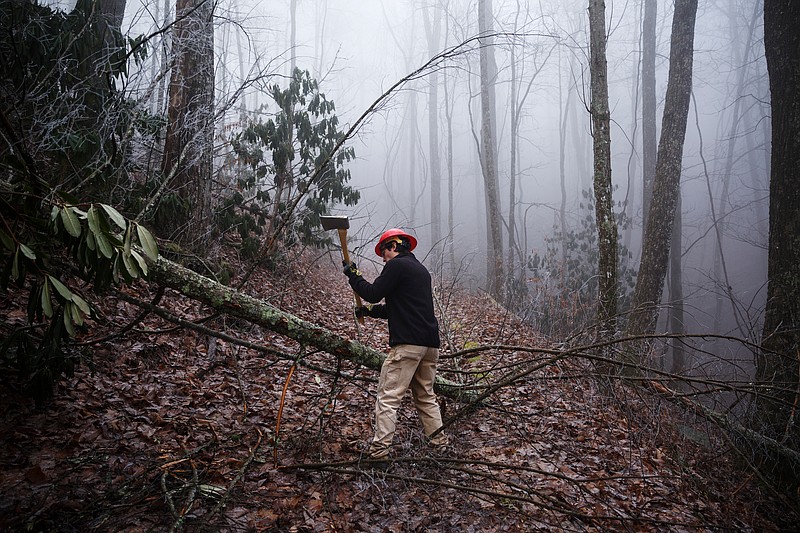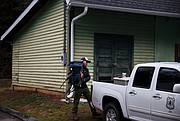Mason Boring and Clayton Morgan held adjoining handles of a perforated lancetooth two-man saw, pulling the more-than-70-year-old piece of equipment back and forth.
The two were clearing a fallen tree from Fodderstack horse and hiking trail in Cherokee National Forest Thursday morning. Boring estimated it had been five years since a crew came to clear the path.
That's what brought the two men here, miles from civilization, hiking and pulling a saw older than many of the surrounding trees.
The drive to the trail was as treacherous as the hike itself. The two had taken a U.S. Forest Service truck more than an hour from any paved road, climbing and climbing and climbing, following what was less road and more dirt and rock path edging the mountainside.
Morgan had already axed the limbs off the downed tree, tossing them aside. It was going to be a hard day of work for the pair.
Boring works for Southern Appalachian Wilderness Stewards (SAWS) – a nonprofit partner of the forest service, where Morgan works. The groups are forbidden by the Wilderness Act of 1964 from using mechanized or gas-powered equipment in the wilderness area.
The purpose is to keep wilderness areas wild. Congress and Wilderness Act supporters wanted to ensure the areas weren't overworked, SAWS Executive Director Bill Hodge said. They would rather see overgrown paths with downed trees than a well-manicured, overworked man-made trail system that only slightly resembles the natural landscape.
"In these wilderness areas, it's great to see what America looked like before man got here," Boring said.
Wilderness areas represent an extreme of trail building and maintenance. However - despite the stringent regulations and abstract rules - the overall process is similar to most trail building and maintenance projects in the region: research the audience and terrain, find funding, acquire land, design the trail, build it and keep it relatively clear of debris.
The first step is knowing the audience, and the terrain can often dictate the user group, Tennessee River Gorge Trust trail designer Mariah Prescott said. Trails built in rural areas up mountains with water crossings are naturally going to be for more experienced hikers than flat trail systems in urban areas, which appeal to a larger user group.
"Researching that is the first step," Prescott said. "You want to find out who your audience is that you're building a trail for."
Once the user group is known, trail-building organizations then work to obtain control of land. And that process can look different for every trail.
The forest service has to determine what to do with land it already has while following strict federal rules. Private groups search, sometimes exhaustively, to find land and funding but are more free to do as they please with the land. Other trails are built on county property, private property or land is donated.
"For [public groups], it's totally different because they have the land and have to decide what to do with it," Lula Lake Land Trust trail builder Pat Kelly said. "For Lula Lake, it's working with private land owners and connecting through there."
The trust envisioned a trail that would connect 120 miles of trails in Chattanooga and the surrounding area. Lula Lake employees worked for a decade to purchase land and reach agreements with private land owners. By the time they got the land, they knew exactly how it was going to be used and built.
It's a process Prescott just went through, as well. She designed Chattanooga's newest trail: Ritchie Hollow. For Prescott, designing and physically building the trail were more difficult than getting the land, which the trust received in a memorandum of understanding from Prentice Cooper State Forest.
A decades-old trail once existed on the land, and remnants of it are still there. The land is also home to moonshine stills and has several scenic water crossings - all of which Prescott wanted to feature on the 2.5-mile hike. She also wanted to connect the Tennessee River to the top of Suck Creek Mountain.
Once land acquisition and design were done for Kelly and Prescott, there was the process of actually building the trail.
Kelly spent two-to-three weeks over a three-month span putting the finishing touches on the connector trail, marking the route, clearing the corridor and renting a machine to help build the trail. That trail system was finished in fall 2017.
For the Ritchie Hollow Trail, Prescott turned to Pat Kelly's wife, Brenna Kelly, who oversees the Southeast Conservation Corps. The corps does much of the technical trail building that is too difficult for volunteers.
"One of the reasons we want to hire SECC is that it would take us an extremely long time to do what they do," Prescott said. "We're small. They are professionals and can get that done well and extremely efficiently."
SECC members aren't the only professional trail builders in the region. Another is Barry Smith, a member of the Professional TrailBuilders Association. Smith has built or helped build close to 200 miles of trails in the region, including at 5Points, Stringer's Ridge and other locations.
"As a contractor, by the time I get there, the studies have been done and everything has been given a green light," Smith said. "So I'll come in, take a topographical map and then take a hike of the proposed route to see how it looks."
Brenna Kelly, Smith and other professionals often work in tandem with volunteers.
Smith got his trail building start volunteering with the Southern Off-Road Bicycle Association of Chattanooga - a 300-member volunteer network of trail builders. The group is a member of the country's largest mountain bike group, International Mountain Bike Association, and has helped build and maintain trails at Raccoon Mountain, Five Points, Enterprise South Nature Park, Stringer's Ridge, Little Cedar Mountain, Raisin Woods, Blankets Creek and Booker T. Washington.
"That's what makes SORBA so valuable," Smith said. "They're the middle man. They can do a combination of working with volunteers or contractors. It's easier for these non-profits to pull a grant than to go through all the red tape of federal and state agencies."
These groups will often spend several months building a trail, and depending on the agreement, will also maintain it once it's finished.
At that point, groups like SORBA, SAWS and other volunteers will partner to travel the region's trail systems, blow away debris, clear downed trees and ensure they are sustainable for current and future generations.
"We're just trying to connect people to their public lands in meaningful and tangible ways," Hodge said.
Contact staff writer Mark Pace at mpace@timesfreepress.com or 423-757-6361. Follow him on Twitter @themarkpace and on Facebook @ChattanoogaOutdoors.

